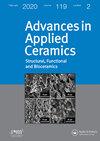Polycarbosilane facilitated growth of SiC nanowires from biowaste coconut shell
IF 1.6
4区 材料科学
Q3 MATERIALS SCIENCE, CERAMICS
引用次数: 3
Abstract
ABSTRACT The SiC nanowires were synthesised by the pyrolysis of a mixture of agricultural waste coconut shell (CS) and polycarbosilane (PCS) precursor at 1400°C. The characterisation of synthesised nanowires was carried out by X-ray diffraction, transmission electron microscopy, and Raman spectroscopy. The single crystalline cubic β-SiC nanowires were found to be grown on <111> directions along (111) planes. The SiC nanowires had striped morphology containing stacking faults and twins as a planar defect. The extensive growth of SiC nanowires was owing to the continuous deposition of SiO and CO gaseous over the tiny SiC nuclei from the amorphous SiOC matrix. The vapour–solid (VS) and vapour–phase (VP) mechanisms have played the dominant role in nanowire formation. The 3C-SiC nanowires had striped morphology containing hexagonal 4H-SiC and 6H-SiC stacking faults.聚碳硅烷促进了生物废椰壳中SiC纳米线的生长
以农业废椰壳(CS)和聚碳硅烷(PCS)前体为原料,在1400℃热解制备了SiC纳米线。通过x射线衍射、透射电子显微镜和拉曼光谱对合成的纳米线进行了表征。单晶立方β-SiC纳米线沿(111)平面方向生长。碳化硅纳米线呈条纹状,含有层错和孪晶等平面缺陷。SiC纳米线的广泛生长是由于SiO和CO气体不断沉积在非晶SiOC基体的微小SiC核上。气固(VS)和气相(VP)机制在纳米线的形成中起主导作用。3C-SiC纳米线呈条纹状,含有六边形的4H-SiC和6H-SiC层错。
本文章由计算机程序翻译,如有差异,请以英文原文为准。
求助全文
约1分钟内获得全文
求助全文
来源期刊

Advances in Applied Ceramics
工程技术-材料科学:硅酸盐
CiteScore
4.40
自引率
4.50%
发文量
17
审稿时长
5.2 months
期刊介绍:
Advances in Applied Ceramics: Structural, Functional and Bioceramics provides international coverage of high-quality research on functional ceramics, engineering ceramics and bioceramics.
 求助内容:
求助内容: 应助结果提醒方式:
应助结果提醒方式:


